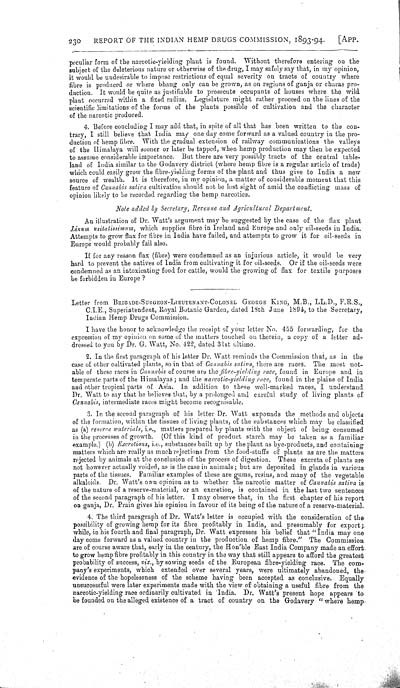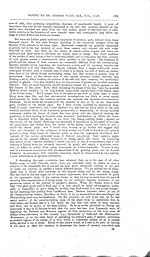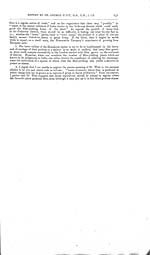Medicine - Drugs > Report of the Indian Hemp Drugs Commission, 1894-1895 > Volume III
(234) Volume 3, Page 230
Thumbnail gallery: Grid view | List view

230 REPORT OF THE INDIAN HEMP DRUGS COMMISSION, 1893-94. [APP.
peculiar form of the
narcotic-yielding plant is found. Without therefore entering on
the
subject of the deleterious nature or otherwise of the drug, I may
safely say that, in my opinion,
it would be undesirable to impose restrictions of equal severity on
tracts of country where
fibre is produced or where bhang only can be grown, as on regions
of ganja or charas pro-
duction. It would be quite as justifiable to prosecute occupants of
houses where the wild
plant occurred within a fixed radius. Legislature might rather
proceed on the lines of the
scientific limitations of the forms of the plants possible of
cultivation and the character
of the narcotic produced.
4. Before concluding I
may add that, in spite of all that has been written to the
con-
trary, I still believe that India may one day come forward as a
valued country in the pro-
duction of hemp fibre. With the gradual extension of railway
communications the valleys
of the Himalaya will sooner or later be tapped, when hemp
production may then be expected
to assume considerable importance. But there are very possibly
tracts of the central table-
land of India similar to the Godavery district (where hemp fibre is
a regular article of trade)
which could easily grow the fibre-yielding forms of the plant and
thus give to India a new
source of wealth. It is therefore, in my opinion, a matter of
considerable moment that this
feature of Cannabis satica cultivation should not be lost
sight of amid the conflicting mass of
opinion likely to be recorded regarding the hemp
narcotics.
Note added by Secretary, Revenue and Agricultural Department.
An illustration of Dr.
Watt's argument may be suggested by the case of the flax
plant
Linum usitatissimum, which supplies fibre in Ireland and
Europe and only oil-seeds in India.
Attempts to grow flax for fibre in India have failed, and attempts
to grow it for oil-seeds in
Europe would probably fail also.
If for any reason flax
(fibre) were condemned as an injurious article, it would be
very
hard to prevent the natives of India from cultivating it for
oil-seeds. Or if the oil-seeds were
condemned as an intoxicating food for cattle, would the growing of
flax for textile purposes
be forbidden in Europe ?
Letter from
BRIGADE-SURGEON-LIEUTENANT-COLONEL GEORGE KING, M.B., L.L.D.,
F.R.S.,
C.I.E., Superintendent, Royal Botanic Garden, dated 18th June 1894,
to the Secretary,
Indian Hemp Drugs Commission.
I have the honor to
acknowledge the receipt of your letter No. 455 forwarding, for
the
expression of my opinion on some of the matters touched on therein,
a copy of a letter ad-
dressed to you by Dr. G. Watt, No. 422, dated 31st
ultimo.
2. In the first
paragraph of his letter Dr. Watt reminds the Commission that, as in
the
case of other cultivated plants, so in that of Cannabis
sativa, there are races. The most not-
able of these races in Cannabis of course are the
fibre-yielding race, found in Europe and in
temperate parts of the Himalayas; and the narcotic-yielding
race, found in the plains of India
and other tropical parts of Asia. In addition to these well-marked
races, I understand
Dr. Watt to say that he believes that, by a prolonged and careful
study of living plants of
Cannabis, intermediate races might become
recognisable.
3. In the second
paragraph of his letter Dr. Watt expounds the methods and
objects
of the formation, within the tissues of living plants, of the
substances which may be classified
as (a) reserve materials, i.e., matters prepared by plants
with the object of being consumed
in the processes of growth. (Of this kind of product starch may be
taken as a familiar
example.) (b) Excretions, i.e., substances built up by the
plant as bye-products, and containing
matters which are really as much rejections from the food-stuffs of
plants as are the matters
rejected by animals at the conclusion of the process of digestion.
These excreta of plants are
not however actually voided, as is the case in animals; but are
deposited in glands in various
parts of the tissues. Familiar examples of these are gums, resins,
and many of the vegetable
alkaloids. Dr. Watt's own opinion as to whether the narcotic matter
of Cannabis sativa is
of the nature of a reserve-material, or an excretion, is contained
in the last two sentences
of the second paragraph of his letter. I may observe that, in the
first chapter of his report
on ganja, Dr. Prain gives his opinion in favour of its being of the
nature of a reserve-material.
4. The third
paragraph of Dr. Watt's letter is occupied with the consideration
of the
possibility of growing hemp for its fibre profitably in India, and
presumably for export;
while, in his fourth and final
paragraph, Dr. Watt expresses his belief that " India may one
day come forward as a valued country in the production of hemp
fibre." The Commission
are of course aware that, early in the century, the Hon'ble East
India Company made an effort
to grow hemp fibre profitably in this country in the way that still
appears to afford the greatest
probability of success, viz., by sowing seeds of the
European fibre-yielding race. The com-
pany's experiments, which extended over several years, were
ultimately abandoned, the-
evidence of the hopelessness of the scheme having been accepted as
conclusive. Equally
unsuccessful were later experiments made with the view of obtaining
a useful fibre from the
narcotic-yielding race ordinarily cultivated in India. Dr. Watt's
present hope appears to
be founded on the alleged existence of a tract of country on the
Godavery " where hemp
Set display mode to: Large image | Zoom image | Transcription
Images and transcriptions on this page, including medium image downloads, may be used under the Creative Commons Attribution 4.0 International Licence unless otherwise stated. ![]()
| India Papers > Medicine - Drugs > Report of the Indian Hemp Drugs Commission, 1894-1895 > Volume III > (234) Volume 3, Page 230 |
|---|
| Description | Volume 3: Appendices. Miscellaneous. |
|---|---|
| Attribution and copyright: |
|




